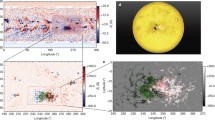Abstract
The generally accepted scenario for the events leading up to a two-ribbon flare is that a magnetic arcade (supporting a plage filament) responds to the slow photospheric motions of its footpoints by evolving passively through a series of (largely) force-free equilibria. At some critical amount of shear the configuration becomes unstable and erupts outwards. Subsequently, the field closes back down in the manner modelled by Kopp and Pneuman (1976); but the main problem has been to explain the eruptive instability.
The present paper analyses the magnetohydrodynamic stability of several possible arcade configurations, including the dominant stabilizing effect of line-tying at the photospheric footpoints. One low-lying force-free structure is found to be stable regardless of the shear; also some of the arcades that lie on the upper branch of the equilibrium curves are shown to be stable. However, another force-free configuration appears more likely to represent the preflare structure. It consists of a large flux tube, anchored at its ends and surrounded by an arcade, so that the field transverse to the arcade axis contains a magnetic island. Such a configuration is found to become unstable when either the length of the structure, the twist of the flux tube, or the height of the island becomes too great; the higher the tube is situated, the smaller is the twist required for instability.
Similar content being viewed by others
References
Anzer, U.: 1968, Solar Phys. 3, 298.
Bernstein, I. B., Frieman, E. A., Kruskal, M. D., and Kulsrud, R. M.: 1958, Proc. Roy. Soc. London A244, 17.
Birn, J., Goldstein, H., and Schindler, K.: 1978a, Solar Phys. 57, 81.
Birn, J., Goldstein, H., and Schindler, K.: 1978b, Proceeding of the 2nd European Solar Meeting, CNRS, Toulouse.
Heyvaerts, J., Priest, E. R., and Rust, D. M.: 1977, Astrophys. J. 216, 123.
Heyvaerts, J., Lasry, J. M., Schatzman, M., and Witomsley, G.: 1979, submitted.
Hood, A. W. and Priest, E. R.: 1979a, Solar Phys. 64, 303.
Hood, A. W. and Priest, E. R.: 1979b, Astron. Astmphys. 77, 233.
Ince, E. L.: 1944, Ordinary Differential Equations, Dover Publications.
Jockers, K.: 1978, Solar Phys. 56, 37.
Kopp, R. A. and Pneuman, G. W.: 1976, Solar Phys. 50, 85.
Low, B. C.: 1977a, Astmphys. J. 212, 234.
Low, B. C.: 1977b, Astmphys. J. 217, 988.
Lüst, R. and Schlüter, A.: 1954, Z. Astmphys. 34, 363.
Newcomb, W.: 1960, Ann. Phys. 10, 232.
Milne, A. M., Priest, E. R., and Roberts, B.: 1979, Astmphys. J. 232, 304.
Priest, E. R.: 1976, in D. J. Williams (ed.), Physics of Solar Planetary Environment, American Geophysical Union, Vol. 1, p. 144.
Priest, E. R. and Milne, A. M.: 1980, Solar Phys. 65, 315.
Tur, T. and Priest, E. R.: 1976, Solar Phys. 48, 89.
Van Tend, W. and Kuperus, M.: 1978, Solar Phys. 59, 115.
Author information
Authors and Affiliations
Rights and permissions
About this article
Cite this article
Hood, A.W., Priest, E.R. Magnetic instability of coronal arcades as the origin of two-ribbon flares. Sol Phys 66, 113–134 (1980). https://doi.org/10.1007/BF00150523
Received:
Issue Date:
DOI: https://doi.org/10.1007/BF00150523




